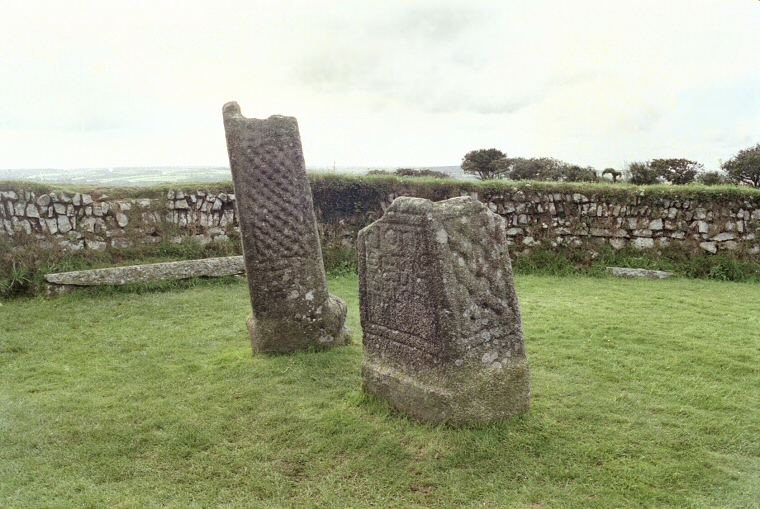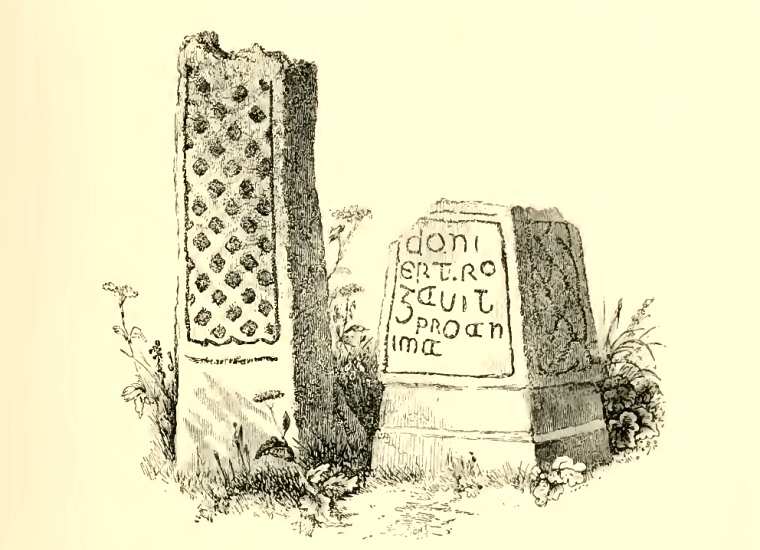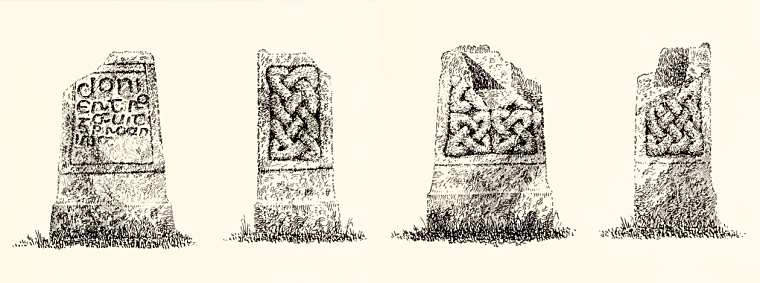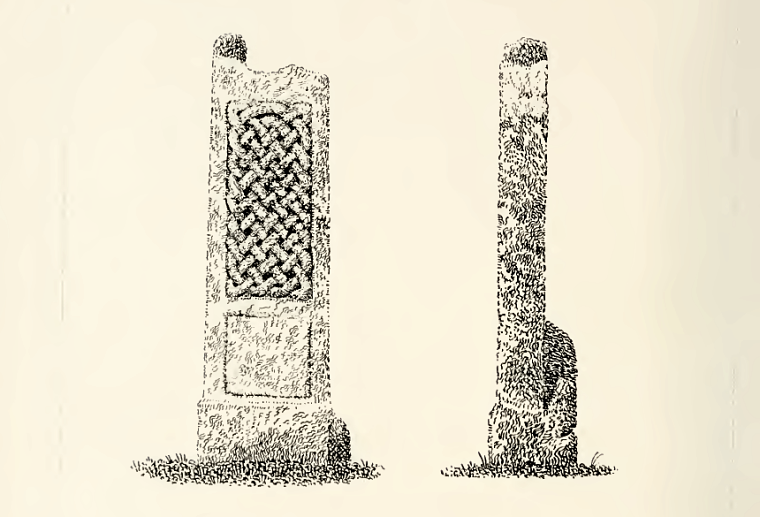 |
Standing on Bodmin Moor, close to Trethevy Quoit and the Hurlers stone circle are the granite bases of two late 9th century crosses. The crosses themselves
were probably wooden and slotted into the sockets on top of the stones although the tops of both now appear to be broken. One of the cross bases is known as King Doniert's Stone (in Cornish - Men Myghtern Doniert) shown in the foreground of the photograph above and is believed to commemorate the last Cornish king, Durngarth, sometimes spelled as Dumgarth, Dungerth or Dwingarth. Durngarth (Duncan in English) is thought to be a descendant of the early 8th century King Gerren as well as being the son of King Caraduc and is said to have held his court in Liskeard (Lis-Cerruyt). The slightly rectangular block of stone stands about 1.4 metres tall and has three faces carved with three different simple but elegant knot-work motifs while the forth face carries the Saxon Latin inscription of 'Doniert Rogavit Pro Anima'. This has been interpreted as either 'Doniert ordered (this cross) for (the good of) his soul', 'Doniert has prayed for his soul' or 'Doniert has begged that prayers be offered for the repose of (his) soul', the king having said to have drowned during a hunting expedition sometime around 875AD. The stone is unusual in that it is only one of two inscribed stones that bear the name a Cornish king and the only one that can be related to a historically documented person. The second cross base which stands 2.1 metres tall is referred to as the 'Other Half Stone' although this apparently this does not allude to the mistaken idea that it may have been a broken off part of Doniert's Stone. The Cornish antiquary William Borlase ascribes its title to the fact that it appears to have been split in two and half of the stone lost, perhaps when the socket for a cross was being cut which would also have rendered it useless for its intended purpose. The remaining front face carries an elaborate knot-work panel (best shown in Arthur Langdon's illustration at the bottom of the page). When King Doniert's Stone was re-erected in 1849 it was found to lying in a previously excavated pit. This was examined again in 1932 and found to be part of a rock-cut underground passage whose age and purpose remains unknown although may have been cut by tin prospectors as long ago as the Iron Age. I've included these stones as despite the fact they belong to the so called Dark Ages rather than prehistory they are easily accessible being close to the road and I've always thought they have a certain poignancy about them. They also fit in well with the much older sites of Cornwall and could almost be seen as a continuation of the standing stone tradition, albeit in a Christianised form.. |
 This illustration of the cross bases by John Thomas Blight from 1858 shows the carving of the text in detail but he seems to have got bored drawing the Other Half Stone and shows the fine knot-work as a simple lattice. |
 Arthur Langdon provides us with a plan of each of the four faces of King Doniert's Stone which also shows the broken socket in which a wooden cross is thought to have been placed. |
 Langdon does a better job than Blight in illustrating the intricate knot-work on the Other Half Stone. |
Site Visits / Photographs: August 1997, August 1999. References: Blight, J. 1858. Ancient Crosses and other Antiquities in the East of Cornwall. London: Simpkin. Borlase, W. 1754. Observations on the Antiquities, Historical and Monumental of the County of Cornwall. Oxford: Clare, T. 1982. Archaeological Sites of Devon and Cornwall. Ashbourne: Moorland Publishing. Laing, L. and Laing, J. 1979. A Guide to the Dark Age Remains in Britain. London: Constable. Langdon, A. 1896. Old Cornish Crosses. Truro: Pollard. Page, W. (ed). 1906. Inscribed Stones in The Victoria History of the County of Cornwall.Vol 1 . London: Weatherhill, C. 1985. Cornovia. Ancient Sites of Cornwall & Scilly. Penzance: Alison Hodge. Historic England Research Records Hob Uid: 435004. HER Number: 17270 National Monument Record Number: SX26NW 34. |